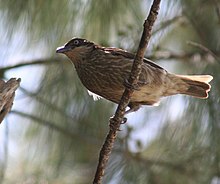
There are 57 species of birds that have been recorded on Niue, of which one has been introduced by humans. Two species are globally threatened. Niue is an island country in the South Pacific, 2,400 kilometres (1,500 mi) northeast of New Zealand.
There are no endemic species surviving today but there are endemic subspecies of the Polynesian triller and Polynesian starling. There are 15 breeding species of which eleven are landbirds and four are seabirds. Studies of fossil birds suggest that Niue's avifauna was formerly more diverse. Birds recorded from subfossil remains predating Polynesian settlement of the island include the Niue night heron (Nycticorax kalavikai), Tongan megapode (Megapodius pritchardii) and the Niue rail (Gallirallus huiatua).
This list's taxonomic treatment (designation and sequence of orders, families and species) and nomenclature (common and scientific names) follow the conventions of The Clements Checklist of Birds of the World, 2022 edition. The family accounts at the beginning of each heading reflect this taxonomy, as do the species counts found in each family account. Introduced and accidental species are included in the total counts for Niue. There are unconfirmed reports of the red-tailed tropicbird (Phaethon rubricauda), Pacific black duck (Anas superciliosa) and sharp-tailed sandpiper (Calidris acuminata) but these are not included in the list.
The following tags have been used to highlight several categories, but not all species fall into one of these categories. Those that do not are commonly occurring native species.
- (A) Accidental – a species that rarely or accidentally occurs in Niue
- (I) Introduced – a species introduced to Niue as a consequence, direct or indirect, of human actions
Ducks, geese, and waterfowl
Order: Anseriformes Family: Anatidae
The family Anatidae includes the ducks and most duck-like waterfowl, such as geese and swans. These are adapted for an aquatic existence, with webbed feet, bills that are flattened to a greater or lesser extent, and feathers that are excellent at shedding water due to special oils.
- Pacific black duck, Anas superciliosa (A)
- Mallard, Anas platyrhynchos (A)
Pheasants, grouse, and allies
Order: Galliformes Family: Phasianidae
The Phasianidae are a family of terrestrial birds which consists of quails, partridges, snowcocks, francolins, spurfowls, tragopans, monals, pheasants, peafowls and jungle fowls. In general, they are plump (although they vary in size) and have broad, relatively short wings.
- Red junglefowl, Gallus gallus (I)
Pigeons and doves
Order: Columbiformes Family: Columbidae
Pigeons and doves are stout-bodied birds with short necks and short slender bills with a fleshy cere.
- Many-colored fruit dove, Ptilinopus perousii
- Crimson-crowned fruit dove, Ptilinopus porphyraceus
- Pacific imperial-pigeon, Ducula pacifica
Cuckoos
Order: Cuculiformes Family: Cuculidae
The family Cuculidae includes cuckoos, roadrunners and anis. These birds are of variable size with slender bodies, long tails and strong legs. The Old World cuckoos are brood parasites.
- Long-tailed koel, Eudynamys taitensis
Swifts
Order: Caprimulgiformes Family: Apodidae
Swifts are small birds which spend the majority of their lives flying. These birds have very short legs and never settle voluntarily on the ground, perching instead only on vertical surfaces. Many swifts have long swept-back wings which resemble a crescent or boomerang.
- White-rumped swiftlet, Aerodramus spodiopygius
- Australian swiftlet, Aerodramus terraereginae
Rails, gallinules, and coots

Order: Gruiformes Family: Rallidae
Rallidae is a large family of small to medium-sized birds which includes the rails, crakes, coots and gallinules. Typically they inhabit dense vegetation in damp environments near lakes, swamps or rivers. In general they are shy and secretive birds, making them difficult to observe. Most species have strong legs and long toes which are well adapted to soft uneven surfaces. They tend to have short, rounded wings and to be weak fliers.
- Buff-banded rail, Gallirallus philippensis
- Australasian swamphen, Porphyrio melanotus (A)
- Spotless crake, Zapornia tabuensis
Plovers and lapwings
Order: Charadriiformes Family: Charadriidae
The family Charadriidae includes the plovers, dotterels and lapwings. They are small to medium-sized birds with compact bodies, short, thick necks and long, usually pointed, wings. They are found in open country worldwide, mostly in habitats near water.
- Pacific golden-plover, Pluvialis fulva
Sandpipers and allies

Order: Charadriiformes Family: Scolopacidae
Scolopacidae is a large diverse family of small to medium-sized shorebirds including the sandpipers, curlews, godwits, shanks, tattlers, woodcocks, snipes, dowitchers and phalaropes. The majority of these species eat small invertebrates picked out of the mud or soil. Variation in length of legs and bills enables multiple species to feed in the same habitat, particularly on the coast, without direct competition for food.
- Bristle-thighed curlew, Numenius tahitiensis (A)
- Far Eastern curlew, Numenius madagascariensis (A)
- Eurasian curlew, Numenius arquata (A)
- Bar-tailed godwit, Limosa lapponica (A)
- Ruddy turnstone, Arenaria interpres
- Sanderling, Calidris alba
- Pectoral sandpiper, Calidris melanotos (A)
- Wandering tattler, Tringa incana
Gulls, terns, and skimmers
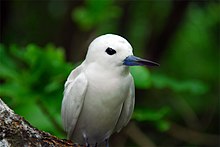
Order: Charadriiformes Family: Laridae
Laridae is a family of medium to large seabirds, the gulls, terns, and skimmers. Gulls are typically grey or white, often with black markings on the head or wings. They have stout, longish bills and webbed feet. Terns are a group of generally medium to large seabirds typically with grey or white plumage, often with black markings on the head. Most terns hunt fish by diving but some pick insects off the surface of fresh water. Terns are generally long-lived birds, with several species known to live in excess of 30 years.
- Kelp gull, Larus dominicanus (A)
- Brown noddy, Anous stolidus
- Black noddy, Anous minutus
- Blue-gray noddy, Anous ceruleus
- White tern, Gygis alba
- Black-naped tern, Sterna sumatrana
- Great crested tern, Thalasseus bergii
Tropicbirds
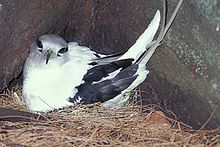
Order: Phaethontiformes Family: Phaethontidae
Tropicbirds are slender white birds of tropical oceans, with exceptionally long central tail feathers. Their heads and long wings have black markings.
- White-tailed tropicbird, Phaethon lepturus
Southern storm-petrels
Order: Procellariiformes Family: Oceanitidae
The southern storm-petrels are the smallest seabirds, relatives of the petrels, feeding on planktonic crustaceans and small fish picked from the surface, typically while hovering. Their flight is fluttering and sometimes bat-like.
- White-bellied storm-petrel, Fregetta grallaria
- Polynesian storm-petrel, Nesofregetta fuliginosa
Shearwaters and petrels
Order: Procellariiformes Family: Procellariidae
The procellariids are the main group of medium-sized "true petrels", characterised by united nostrils with medium septum and a long outer functional primary.
- Southern giant-petrel, Macronectes giganteus (A)
- Kermadec petrel, Pterodroma neglecta
- Herald petrel, Pterodroma heraldica
- Mottled petrel, Pterodroma inexpectata
- White-necked petrel, Pterodroma cervicalis
- Black-winged petrel, Pterodroma nigripennis
- Collared petrel, Pterodroma brevipes
- Phoenix petrel, Pterodroma alba
- Tahiti petrel, Pseudobulweria rostrata
- Wedge-tailed shearwater, Ardenna pacificus
- Buller's shearwater, Ardenna bulleri
- Sooty shearwater, Ardenna grisea
- Short-tailed shearwater, Ardenna tenuirostris
- Tropical shearwater, Puffinus bailloni
Frigatebirds
Order: Suliformes Family: Fregatidae
Frigatebirds are large seabirds usually found over tropical oceans. They are large, black and white or completely black, with long wings and deeply forked tails. The males have coloured inflatable throat pouches. They do not swim or walk and cannot take off from a flat surface. Having the largest wingspan-to-body-weight ratio of any bird, they are essentially aerial, able to stay aloft for more than a week.
- Lesser frigatebird, Fregata ariel
- Great frigatebird, Fregata minor (A)
Boobies and gannets
Order: Suliformes Family: Sulidae
The sulids comprise the gannets and boobies. Both groups are medium-large coastal seabirds that plunge-dive for fish.
- Masked booby, Sula dactylatra (A)
- Brown booby, Sula leucogaster
Herons, egrets, and bitterns
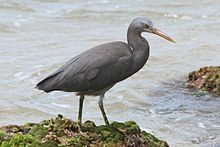
Order: Pelecaniformes Family: Ardeidae
The family Ardeidae contains the bitterns, herons, and egrets. Herons and egrets are medium to large wading birds with long necks and legs. Bitterns tend to be shorter necked and more wary. Members of Ardeidae fly with their necks retracted, unlike other long-necked birds such as storks, ibises and spoonbills.
- White-faced heron, Egretta novaehollandiae (A)
- Pacific reef-heron, Egretta sacra (A)
Barn-owls
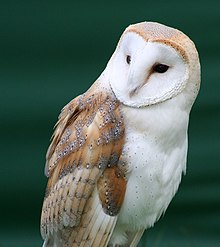
Order: Strigiformes Family: Tytonidae
Barn-owls are medium to large owls with large heads and characteristic heart-shaped faces. They have long strong legs with powerful talons.
- Eastern barn owl, Tyto javanica
Old World parrots

Order: Psittaciformes Family: Psittaculidae
- Blue-crowned lorikeet, Vini australis
Cuckooshrikes

Order: Passeriformes Family: Campephagidae
The cuckooshrikes are small to medium-sized passerine birds. They are predominantly greyish with white and black, although some species are brightly coloured.
- Polynesian triller, Lalage maculosa
Bulbuls
Order: Passeriformes Family: Pycnonotidae
Bulbuls are medium-sized songbirds. Some are colourful with yellow, red or orange vents, cheeks, throats or supercilia, but most are drab, with uniform olive-brown to black plumage. Some species have distinct crests.
- Red-vented bulbul, Pycnonotus cafer (A)
Starlings
Order: Passeriformes Family: Sturnidae
Starlings are small to medium-sized passerine birds. Their flight is strong and direct and they are very gregarious. Their preferred habitat is fairly open country. They eat insects and fruit. Plumage is typically dark with a metallic sheen.
- Polynesian starling, Aplonis tabuensis
See also
References
- ^ Watling, Dick (2001) A Guide to the Birds of Fiji & Western Polynesia, Environmental Consultants (Fiji), Suva.
- ^ Worthy T. H.; Walter, R. & Anderson, Atholl (1998) Fossil and archaeological avifauna of Niue Island, Pacific Ocean Archived 2008-10-17 at the Wayback Machine. Notornis, 45: 177–190.
- Steadman, David W.; Worthy, Trevor H.; Anderson, Atholl & Walter, Richard. (1 June 2000). "New species and records of birds from prehistoric sites on Niue, southwest Pacific". Wilson Bulletin. 112 (2): 165–186. doi:10.1676/0043-5643(2000)112[0165:NSAROB]2.0.CO;2. Archived from the original on 24 May 2007.(subscription required)
- Clements, James F. (2000). Birds of the World: A Checklist. Cornell University Press. p. 880. ISBN 0-934797-16-1.
- Lepage, Denis. "Checklist of Birds of Niue". Bird Checklists of the World. Avibase. Retrieved 1 December 2021.